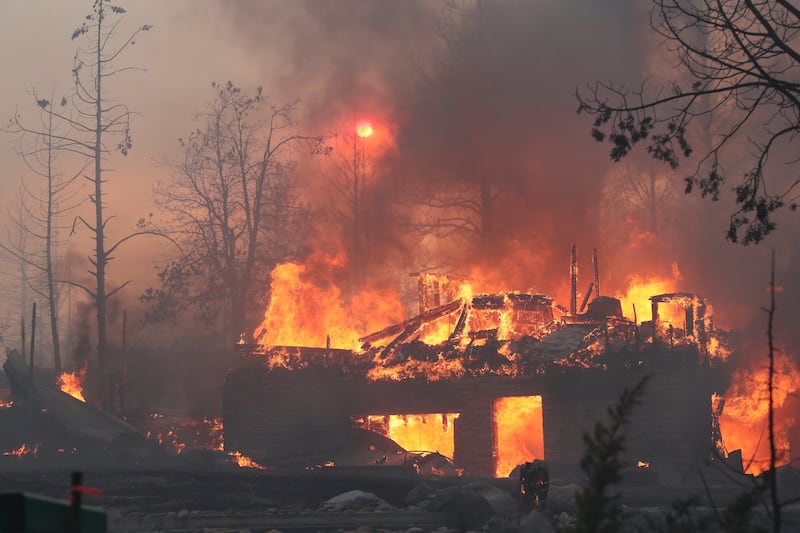Around 100 homes and other structures have been destroyed in a Northern California wildfire that put thousands of people under evacuation orders.
Fire officials said improved weather conditions helped slow the Mill Fire, which is burning 402km (250 miles) north of San Francisco.
The fire began on Friday afternoon near the city of Weed.
At least two people were injured in the fire, one of three major blazes that forced large-scale evacuations in recent days as California swelters under a heat wave expected to last through until Monday.
READ MORE
Evacuees described heavy smoke and chunks of ash raining down.
Annie Peterson said she was sitting on the porch of her home near Roseburg Forest Products, which manufactures wood veneers, when “all of a sudden we heard a big boom and all that smoke was just rolling over toward us”.
Very quickly her home and about a dozen others were on fire. She said members of her church helped evacuate her and her son, who is immobile. She said the scene of smoke and flames looked like “the world was coming to an end”.

Allison Hendrickson, spokeswoman for Dignity Health North State hospitals, said two people were brought to Mercy Medical Centre Mount Shasta. One was in a stable condition and the other was transferred to UC Davis Medical Centre, which has a burns unit.
Rebecca Taylor, of Roseburg Forest Products, said it is unclear if the fire started near or on company property. A large empty building had burned, she said, but all employees were evacuated and none have reported injuries.
California is in a deep drought as it heads into what is traditionally the worst of the fire season.
Cal Fire Siskiyou Unit chief Phil Anzo said crews worked all day and night to protect structures in Weed and in a subdivision to the east known as Carrick Addition.
“There’s a lot at stake on that Mill Fire,” he said. “There’s a lot of communities, a lot of homes there.”

Weather conditions improved overnight and firefighters were able to get 20 per cent containment, but another blaze, the Mountain Fire, that broke out on Friday north-west of Weed grew substantially.
No injuries or buildings had been reported lost in that fire. The causes for both fires are under investigation.
Governor Gavin Newsom declared a state of emergency for Siskiyou County and said a federal grant had been received “to help ensure the availability of vital resources to suppress the fire”.
At about the time the blaze started, power outages were reported that affected some 9,000 customers, and several thousand remained without electricity late into the night, according to an outage website for power company PacifiCorp, which said they were due to the wildfire.
It was the third large wildfire in as many days in California, which has been in the grip of a prolonged drought and is now sweltering under a heatwave that is expected to push temperatures past 37C in many areas through Labour Day.
Thousands were also ordered to flee on Wednesday from a fire in Castaic, north of Los Angeles, and a blaze in eastern San Diego County near the Mexican border left two people severely burned and several homes destroyed. Those fires are now 56 per cent and 65 per cent contained, respectively, and all evacuations have been lifted.
Scientists say climate change has made the US west warmer and drier over the last three decades and will continue to make weather more extreme and wildfires more frequent and destructive.
In the last five years, California has experienced the largest and most destructive fires in state history. Weed has seen three major fires since 2014. — AP












